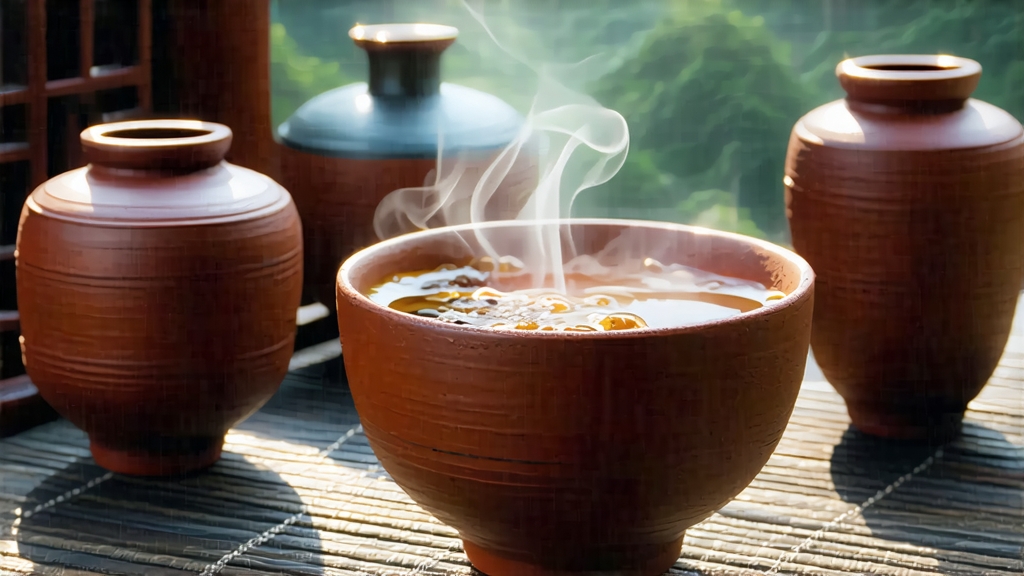
Liu Bao, pronounced “lee-ow bao,” is the quiet diplomat of China’s dark-tea family. While Pu-erh steals headlines, this Guangxi native has spent four centuries smoothing diplomatic relations, financing caravans, and mellowing in bamboo baskets until its liquor glows like antique mahogany. To meet Liu Bao is to taste the humidity of the subtropical Nanling Mountains, the mineral breath of the Liujiang River, and the patience of farmers who still narrate their craft in the cadence of Song-dynasty tea poems.
History: From Border Currency to Imperial Tribute
The story begins in the early 1600s when Wuzhou city’s teahouses served compressed leaf bricks as loose change for merchants from Yunnan, Guangdong, and Indochina. Caravans crossing the misty Dalou Ridge discovered that the humid journey actually improved the tea, turning harsh green roughness into a honeyed, earthy depth. By the Qing Qianlong era (1736–1795), Liu Bao had climbed the bureaucratic ladder to become imperial tribute, shipped north in double-layered bamboo husks sealed with tung oil. In 1886, the first “China Tea Company” steamship left Wuzhou for Hong Kong, and Liu Bao sailed with it, establishing a diaspora that still stocks Malaysian kopitiam shelves and Singaporean medicinal halls. During the Pacific War the leaf doubled as barter currency in Guangxi’s mountain markets; locals recall buying salt, kerosene, and even school tuition with measured squares of 1938-vintage Liu Bao.
Micro-terroirs within 30 km of Wuzhou
Unlike Pu-erh’s vast Yunnan canvas, Liu Bao’s heartland is a pocket-handkerchief of folded valleys. The three celebrated micro-terroirs are:
- Liuxiang: 300–500 m elevation, red lateritic soil rich in iron oxide, giving cocoa-bass notes and a lingering betel-nut coolness.
- Heishi: ancient mining country, granite bedrock, cooler nights; teas here carry iris and wet slate aromas, higher acidity that ages into dried-longan sweetness.
- Dazhushan: highest gardens at 800 m, shrouded in cloud drip; leaves are smaller, yield lower, but develop camphor and sandalwood after a decade.
Farmers still classify leaf by four traditional sizes—“sparrow-tongue,” “olive-core,” “middle-open,” and “large-open”—each destined for different stages of the pile-fermentation schedule.
Craft: When Microbes Conduct a Mountain Symphony
Harvest follows the lunar calendar: one bud-two leaves plucked before Qingming for fragrance, one bud-three or four leaves after Grain Rain for body. The leaves are carried in bamboo baskets down narrow footpaths where the air smells of wild mandarin peel and river stones.
Withering: 4–6 hours on raised bamboo trays in shaded sheds; moisture drops to 65 %, cell walls begin to sigh.
Fixation: 280 °C wok-toss for 3–4 minutes; the goal is to arrest oxidation yet keep enzymatic whisper alive for later microbial acts.
Rolling: A curious 30-minute “walking-press”—the farmer circles a bamboo mat barefoot, rolling the leaf into tight strips without crushing the veins.
Piling: The signature step. Leaves are heaped 70 cm deep inside cedar-lined rooms at 28 °C and 85 % humidity. A naturally occurring consortium of Aspergillus niger, Blastobotrys adeninivorans, and local Candida strains proliferates. Every 48 hours the pile is turned, sprayed with mountain spring water, and “sung to”—yes, workers hum folk tunes whose 108-beat rhythm matches the turning cadence. After 25–30 days the leaf turns chestnut-brown, and a sweet loam aroma rises like warm compost under forest leaves.
Drying: Wood-charcoal baskets hold the leaf 40 cm above a gentle ember for 12 hours; temperature never exceeds 60 °C, preserving fungal spores that will continue aging.
Steaming & pressing: The leaf is re-steamed for 90 seconds, then pressed into 500 g baskets lined with bamboo skin and a single wild taro leaf for moisture buffer. Seven baskets are stacked, tied with rattan, and left to season for 90 days in riverside warehouses where humidity swings between 70 % and